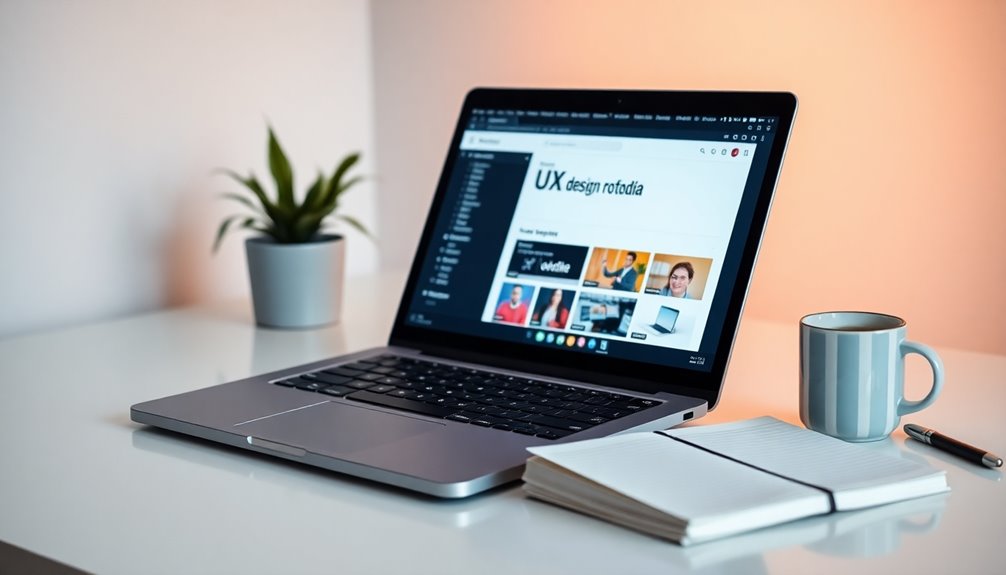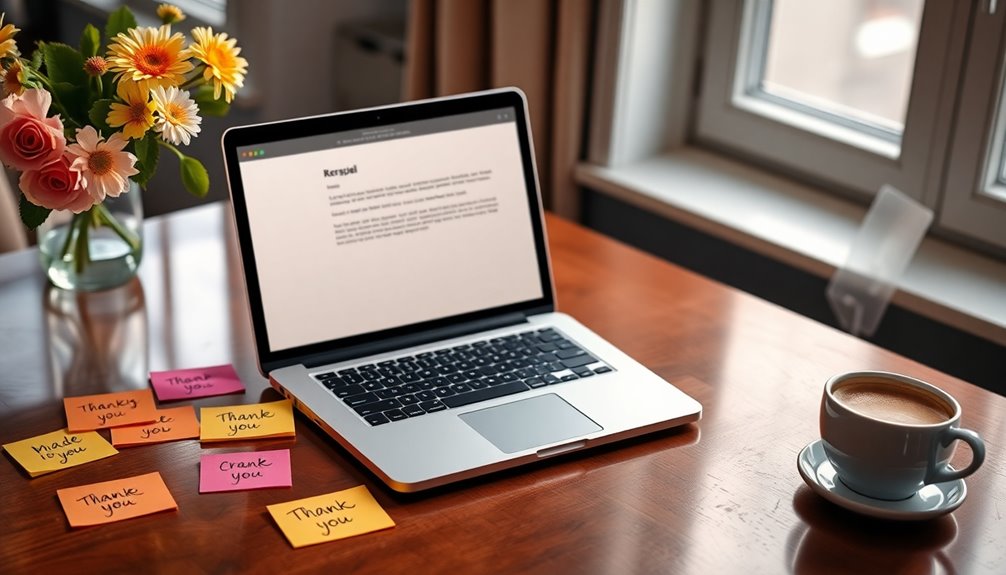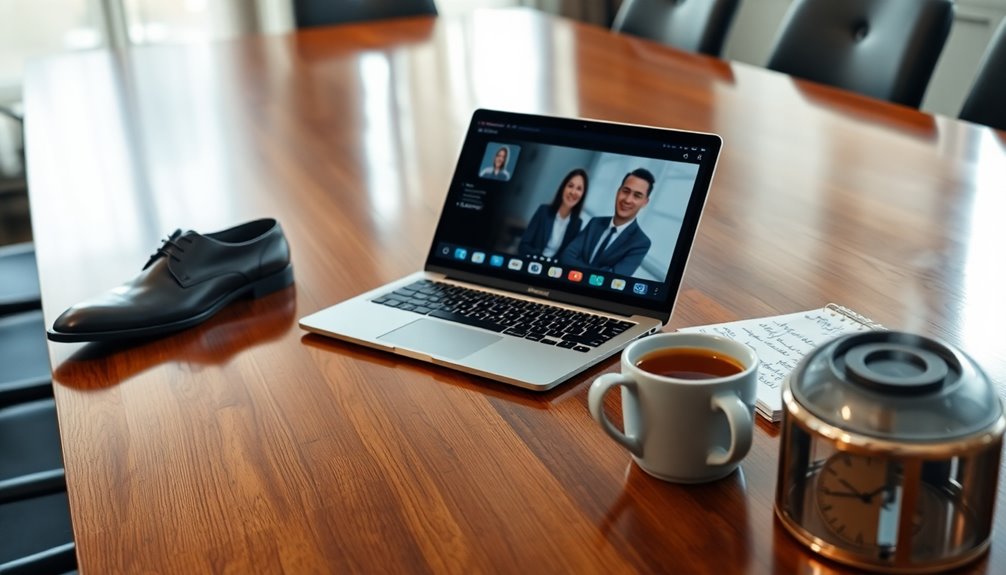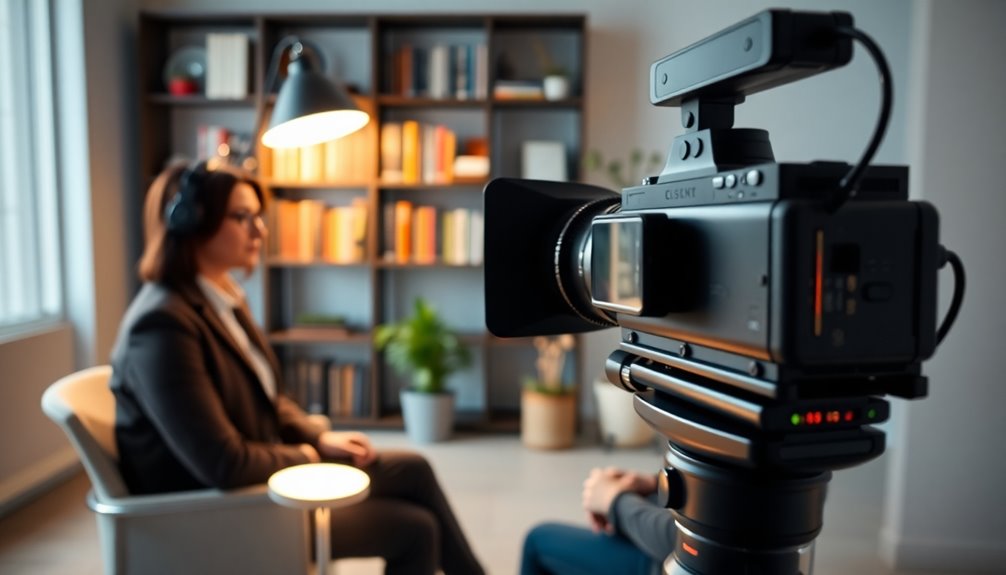To dominate your AI UX designer interview, focus on preparation and showcasing your expertise. Start by researching the company's AI projects and values. Utilize the STAR method to articulate your experiences clearly, while practicing mock interviews for effective presentation. Dress professionally to make a strong first impression, and use confident body language to engage your interviewers. Don't forget to ask insightful questions about their UX processes; it shows genuine interest. These foundational techniques set you up for success, but #10 is a total game changer that you won't want to miss!
Key Takeaways
- Familiarize yourself with the company's AI projects to tailor your responses and demonstrate relevant knowledge during the interview.
- Use the STAR method to articulate your experiences effectively, showcasing problem-solving skills and design impact.
- Prepare a concise portfolio presentation, emphasizing user-centered design processes and measurable outcomes to impress interviewers.
- Engage actively in the conversation by mirroring the interviewer's body language to build rapport and connection.
- Follow up with a personalized thank-you message within 24 hours, referencing specific discussion points to reinforce interest and attentiveness.
Introduction to Job Interviews

When you're preparing for a job interview in UX design, it's essential to understand that this is your chance to showcase not just your skills but also how well you fit into a company's culture. UX design is all about understanding users, so demonstrating your knowledge of user-centered design principles is crucial. You'll likely face various interview formats, including behavioral interviews and portfolio reviews, which will assess your technical abilities and interpersonal skills.
Be ready to articulate your design process and explain your strengths and weaknesses. Using the STAR method can help you effectively communicate your experiences. For example, discuss a situation where you faced a design challenge, the task you undertook, the action you implemented, and the result that followed. This structured approach allows you to convey your problem-solving abilities clearly.
Moreover, staying engaged with industry trends and emerging technologies can enhance your appeal. Companies are looking for candidates who are not only skilled but also eager to learn and adapt. By preparing thoughtfully, you position yourself as a strong contender in the competitive field of UX design.
Preparing for the Interview

To prepare for your AI UX designer interview, start by researching the company's AI projects and their UX design approach. You'll want to assess your skills and experiences to align them with what the company values. Finally, focus on creating a polished resume and practicing interview techniques that highlight your unique qualifications.
Research and Self-Assessment
Preparing for an AI UX designer interview requires a blend of thorough research and honest self-assessment. Start by diving deep into the company's AI projects and design principles. Understanding their specific challenges and goals allows you to tailor your responses effectively, showcasing your fit for the role. For your self-assessment, identify key projects that highlight your strengths in user-centered design and AI integration. This will help you articulate your contributions during the interview, ensuring you present your best performance.
Stay updated on current trends in AI and UX design. Discussing innovations or relevant methodologies will demonstrate your industry knowledge and adaptability. Additionally, prepare a list of thoughtful questions about the company's UX processes and how they incorporate user feedback in their AI projects. This shows genuine interest and engagement, setting you apart from other candidates.
Finally, reflect on your design philosophy and how it aligns with the company's values. Presenting a cohesive narrative about your approach to problem-solving in AI UX design can resonate well with interviewers, further solidifying your candidacy. Balancing research and self-assessment is key to your success. Moreover, consider adopting an MVP approach to quickly test and refine your design ideas, ensuring they meet user needs effectively.
Resume and Application Preparation
Your resume and application play a vital role in making a strong first impression for an AI UX designer position. To stand out, tailor your resume to highlight relevant UX design skills and experience. Focus on super specific projects that showcase your understanding of user-centered design principles and proficiency in tools like Sketch, Figma, or Adobe XD.
Quantifiable achievements are commonly used to demonstrate the impact of your work. Include metrics that show improved user engagement or increased conversion rates to illustrate your design effectiveness.
Your portfolio should reflect quality over quantity. Curate it to showcase your best projects, emphasizing the design process, your role, and the outcomes.
Next one, research the company's culture and values. Align your application with their expectations to show how your skills can contribute to their goals.
Finally, prepare a concise narrative of your career journey. Use the STAR method (Situation, Task, Action, Result) to effectively convey challenges you've overcome and your aspirations. This approach not only highlights your experience but also connects it to the role you're pursuing. Additionally, consider engaging in community or group activities to enhance your network and gain insights that can strengthen your application.
Interview Preparation Techniques
Mastering interview preparation techniques is essential for landing an AI UX designer role. To get started, make sure you research the company's use of AI and UX design principles. Tailor your responses to demonstrate your understanding of their specific needs and challenges. Next, prepare a curated portfolio that highlights your best projects, focusing on your role, design decisions, and user-centered design relevance, especially in AI applications.
Familiarizing yourself with common UX interview formats—like behavioral interviews and design critiques—is crucial. This knowledge helps you effectively convey your thought process and problem-solving skills. Practice articulating your design rationale and decision-making processes, particularly related to AI projects, to showcase your ability to balance innovation with user-centered design principles.
Engaging in mock interviews with peers or mentors will refine your communication skills. This practice allows you to receive feedback on your approach to presenting your portfolio and discussing design challenges, ensuring you're really quick on your feet during the actual interview. With these techniques in hand, you'll boost your confidence and increase your chances of making a lasting impression. Additionally, consider how the principles of coffee culture can inspire creativity in your design process, as both fields emphasize user engagement and community connection.
Dressing for Success

When it comes to dressing for your UX design interview, your outfit speaks volumes before you even say a word. You'll want to consider general attire guidelines, gender-specific tips, and how to adapt your look for different seasons or casual settings. A polished, appropriate appearance can boost your confidence and leave a lasting impression on hiring managers.
General Attire Guidelines
Dressing professionally for an AI UX designer interview often sets the tone for how you're perceived by potential employers. Studies show that 55% of first impressions are based on appearance alone, so it's crucial to make a good one. Aim for a polished look that aligns with the company culture; business casual attire is usually appropriate for tech companies, while startups might prefer a more relaxed style.
Opt for well-fitted clothing in neutral or muted colors to enhance your professionalism. This way, the focus stays on your skills and qualifications rather than your outfit. Pay close attention to grooming and personal hygiene, as 70% of hiring managers believe a candidate's grooming reflects their professionalism and attention to detail.
Accessorize minimally to avoid distractions. Choose simple items that complement your attire without overpowering your overall look. This thoughtful approach not only boosts your confidence but also shows that you respect the opportunity and the interviewers' time. Remember, your goal is to present a strong, professional image that highlights your capabilities as an AI UX designer.
Gender-Specific Attire Tips
Understanding how to dress for success can vary based on gender, with each presenting unique opportunities to showcase professionalism and confidence. For men, opting for a tailored suit in neutral colors like navy or charcoal is essential. Pair it with a crisp white or light blue shirt; this classic look conveys professionalism in a tech-focused environment.
For women, a well-fitted blazer over a blouse, combined with tailored trousers or a knee-length skirt strikes the right balance between authority and approachability—key traits for UX design roles. Footwear matters, too. Men should wear polished leather shoes, while women should select comfortable closed-toe heels or flats to maintain a composed image throughout the interview.
When it comes to accessories, keep it minimal and tasteful. Men can wear a classic watch, while women should opt for subtle jewelry to enhance professionalism without being distracting. Lastly, ensure your attire is clean and pressed. Attention to detail in dress not only reflects your seriousness but also shows respect for the opportunity at hand. Dressing appropriately sets the stage for a successful interview, allowing your skills and personality to shine. Additionally, creating a serene working environment with natural materials and soft colors can help to promote mindfulness and presence, which may enhance your performance during the interview.
Seasonal and Casual Attire
While you want to present yourself professionally in an AI UX designer interview, it's equally important to balance that with a sense of personal style and comfort, especially considering the season. Your appearance significantly influences first impressions, with 55% of them based on how you look. Casual attire, like tailored jeans paired with a smart shirt, strikes a perfect balance between professionalism and approachability in the creative UX field.
Think about seasonal attire too. In summer, opt for breathable fabrics to stay comfortable, while in colder months, layering can help you manage temperature fluctuations in the office. Your outfit should reflect not just professionalism but also a hint of your personality. Incorporating subtle elements, like unique accessories, allows you to express your creativity while still looking polished.
Finally, remember that 70% of hiring managers consider cultural fit during interviews. Aligning your attire with the company's environment and values can showcase your compatibility. So, research the company culture and dress accordingly to make a lasting impression. By striking the right balance, you'll not only look good but also feel confident during your interview. Moreover, understanding the cost of home security systems can help you relate to a company's focus on safety and professionalism, which may resonate well in your interview.
Mastering Interview Questions

Mastering interview questions is crucial for landing a UX design role. You'll need to prepare for common, behavioral, and industry-specific inquiries while honing your responses with advanced techniques. By understanding the nuances of these questions, you can effectively showcase your skills and experiences.
Common Interview Questions
Preparing for common interview questions as a UX designer requires a strategic approach to effectively showcase your skills and experiences. You'll likely face questions about your design process, so be ready to use the STAR method. Articulate specific situations where you faced challenges, the tasks involved, the actions you took, and the results you achieved.
Expect to discuss your favorite and least favorite design projects. Explain your reasoning behind these choices and demonstrate your ability to critique your work and learn from experiences. Interviewers also want to know about your user research methodologies and usability testing experience, so be prepared to highlight your understanding of user-centered design principles.
Collaboration with cross-functional teams is another focus area. Prepare narratives that illustrate effective communication and teamwork in your past projects. Finally, stay updated on industry trends, especially in the realm of AI. Be ready to discuss how you'd adapt your design strategies to incorporate emerging technologies. Additionally, understanding software development life cycle (SDLC) is crucial for integrating design processes with development workflows. By anticipating these common questions, you'll position yourself as a knowledgeable and adaptable candidate, ready to take on the challenges of a UX designer role.
Behavioral and Situational Questions
Behavioral and situational questions play a vital role in assessing how you've handled past challenges and your approach to problem-solving in real-world scenarios. Companies often use the STAR method (Situation, Task, Action, Result) to evaluate your experiences, so it's crucial to prepare structured responses.
Think about specific instances where you demonstrated problem-solving abilities, teamwork, and leadership. Highlight your contributions and the outcomes of those situations to provide clear narratives during the interview. Common questions may include topics like overcoming challenges, handling feedback, or navigating conflicts. Having these stories ready can significantly boost your confidence and articulation.
Don't forget that cultural fit matters just as much as technical skills. When answering, align your experiences with the organization's values and collaborative environment. This demonstrates not only your qualifications but also your understanding of their culture. Additionally, consider incorporating audience engagement strategies to enhance your communication skills during the interview process.
Industry-Specific Questions
When it comes to industry-specific questions, you should expect inquiries that dig deep into your understanding of user-centered design principles as they relate to AI technologies. Interviewers want to see how well you grasp the nuances of designing for AI, so be prepared to discuss your experience with data-driven design methodologies. Employers are looking for candidates who can effectively leverage data to enhance user experiences and make informed design decisions.
Don't overlook current challenges in UX for AI, like balancing innovation with usability and addressing the ethical implications of AI in design. These topics often come up in interviews, and you'll need to articulate your thoughts clearly. Be ready to explain how you integrate emerging technologies while prioritizing user needs amid the complexities of AI applications.
Moreover, you should provide concrete examples of how you've applied user research methodologies in AI projects. Sharing specific insights that informed your design strategies will demonstrate your ability to improve overall product outcomes. Additionally, consider discussing how you ensure data privacy concerns are addressed in your design process to foster trust among users. By preparing for these industry-specific questions, you'll show interviewers that you're not only knowledgeable but also relevant in the rapidly evolving field of AI UX design.
Advanced Question Techniques
Interviewers often focus on advanced questioning techniques to gauge your depth of experience and critical thinking in AI UX design. To excel, master the STAR method (Situation, Task, Action, Result). This approach helps you structure your responses effectively, showcasing your problem-solving and design thinking skills during behavioral questions.
Prepare for inquiries about user research methodologies. Understanding these techniques highlights your user-centered design approach, which is crucial in AI projects. Anticipate questions regarding your design critiques—analyze a favorite and least favorite app to articulate your design priorities and reasoning. This demonstrates your analytical capabilities.
Be ready to discuss how you've integrated UX principles into AI projects. Emphasize the importance of early UX involvement to avoid pitfalls that lead to the failure of 85% of AI initiatives. This insight not only illustrates your expertise but also your foresight in project planning. Additionally, consider how advance directives can inform user experience design in healthcare applications, ensuring that designs meet the needs of users in critical situations.
Finally, practice articulating your design decisions and rationale clearly. This skill showcases your technical knowledge and ability to communicate effectively within cross-functional teams, making you a strong candidate in the competitive AI UX landscape.
Asking Insightful Questions

Asking strategic questions during your interview can set you apart and show your critical thinking skills. Focus on the company's approach to UX and AI integration, and inquire about the tools they use to enhance user experiences. Ending with closing questions about future directions for UX design signals your commitment to growth and innovation in the field.
Strategic Questions to Impress
Strategic questions can significantly enhance your interview experience and showcase your genuine interest in the role and company. By asking insightful questions, you not only demonstrate your knowledge but also align yourself with the team's values and culture.
Start by inquiring about the company's approach to integrating UX design in AI projects. This shows you recognize the unique challenges and opportunities in this evolving field. Next, ask about the tools and methodologies the design team uses for user research. This highlights your understanding of user-centered design principles and readiness to jump in.
Additionally, you might want to ask how the design team measures success in their projects. This reflects your focus on results-driven design and your intention to align your work with the company's goals. Furthermore, engaging in discussions about the future of UX design within the organization demonstrates your forward-thinking mindset. It positions you as someone eager to contribute to innovations and improvements.
Incorporating these strategic questions into your interview not only impresses your interviewers but also helps you assess whether the company is the right fit for you.
Closing Questions
Closing your interview with insightful questions can leave a lasting impression on your interviewers and show your enthusiasm for the role. It's your chance to demonstrate genuine interest in the company and the position. Start by inquiring about the company's approach to integrating UX design within AI projects. This question reveals how they prioritize user-centered design, a crucial aspect of the role.
Next, ask about the challenges the team faces in UX design for AI applications. This shows you're aware of the complexities involved and can lead to a more engaging discussion about the field. You might also want to explore the future direction of UX design within the company. This highlights your forward-thinking mindset and eagerness to grow alongside the organization.
Finally, don't hesitate to request feedback on your interview performance. This not only provides valuable insights for your future interviews but also demonstrates your commitment to continuous improvement in your professional development. By asking these thoughtful questions, you'll reinforce your interest in the role and leave your interviewers with a favorable impression of your proactive approach.
Effective Communication and Presentation

When you're crafting the perfect response, focus on clarity and relevance to keep the interviewer's attention. Your body language and confidence play crucial roles in how your message is received, so practice projecting assurance and engagement. Together, these elements can significantly enhance your communication and presentation skills during the interview.
Crafting the Perfect Response
Crafting the perfect response during an AI UX designer interview hinges on your ability to communicate your design choices effectively. You need to clearly articulate your decisions and the rationale behind them, showcasing your grasp of user-centered design principles. One effective approach is the STAR method, which helps you structure your responses to behavioral questions by outlining the Situation, Task, Action, and Result. This method presents your experiences in a clear and compelling manner.
Engaging with your interviewers is equally important. Ask insightful questions about their design processes and tools, demonstrating your genuine interest in the role while highlighting your proactive engagement skills.
Don't forget to prepare a concise portfolio presentation that spotlights your best projects. Include the background, your specific role, design decisions made, and measurable success metrics to convey your impact effectively. Additionally, understanding utilitarian principles can provide a strong ethical framework for your design choices, showing your ability to balance user needs with broader societal impacts.
Lastly, practice mock interviews to refine your communication style and presentation skills. This preparation ensures you can convey complex ideas clearly and confidently, even in high-pressure situations. By mastering these techniques, you'll be well on your way to impressing your interviewers and landing your dream AI UX designer role.
Body Language and Confidence
Effective communication goes beyond what you say; it also involves how you present yourself. Nonverbal cues, like maintaining eye contact and adopting an open posture, can significantly enhance your confidence and engagement during interviews. These subtle signals can positively influence the interviewer's perception of your communication skills. In fact, studies show that confident body language can boost your perceived competence by up to 30%.
To convey assurance, practice using hand movements to emphasize your points. Before the interview, try power poses to reduce anxiety and increase self-confidence. A firm handshake and a warm smile can set a positive tone, making you appear approachable right from the start.
Additionally, effective communicators often mirror the body language of their interviewers. This technique creates a sense of rapport, making the interaction more comfortable for both of you. Remember, how you carry yourself speaks volumes. By mastering your body language, you not only enhance your confidence but also improve the overall impression you leave during the interview. So, focus on these techniques to ensure you present the best version of yourself when it matters most.
Post-Interview Strategies

After your interview, follow-up communications can make a big difference in how you're perceived. Whether you're handling an offer or a rejection, it's essential to respond thoughtfully and professionally. Let's explore how effective post-interview strategies can strengthen your candidacy and set the stage for future opportunities.
Follow-Up Communications
Sending a thoughtful follow-up communication can significantly impact your chances of landing the job. A personalized thank-you email sent within 24 hours of your interview shows your genuine interest and helps leave a positive impression on the interviewers. In your message, reference specific topics you discussed; this demonstrates your attentiveness and strengthens your connection with them.
Don't forget to include a brief summary of your relevant skills or experiences that align with the role. This serves as a reminder of your qualifications and the unique value you can bring to their team. If you received any feedback or a timeline for their hiring decision during the interview, mention it in your follow-up. This not only shows your proactive engagement but also indicates you're attentive to the process.
Finally, maintain a polite and patient tone throughout your follow-up communications. This approach reflects your professionalism and respect for their decision-making timeline. By following these steps, you'll enhance your chances of standing out positively in the minds of your interviewers, making your candidacy even stronger.
Handling Offers and Rejections
Navigating the emotions of receiving a job offer or facing rejection can be challenging, but handling these situations with grace is essential. When you receive an offer, take the time to carefully evaluate the terms and conditions. Consider factors like salary, benefits, company culture, and growth opportunities before making your decision.
If you encounter a rejection, don't let it discourage you. Promptly send a thank-you email expressing your appreciation for the opportunity. This gesture helps maintain a positive relationship and keeps the door open for future opportunities.
Regardless of the outcome, always request feedback after an interview. This can provide valuable insights into areas for improvement and shows your willingness to learn and grow as a designer.
Stay connected with interviewers and company representatives on professional networks like LinkedIn. This demonstrates your continued interest in the organization and can lead to potential future opportunities.
Finally, reflect on your interview experience. Analyzing both your successes and areas where you can improve will enhance your performance in future interviews and sharpen your approach as a candidate.
Remote Interviewing Best Practices

When you're preparing for a remote interview, understanding the technology you'll use is crucial. You also need to be aware of cultural nuances that can affect communication, especially in a global work environment. Plus, staying updated on emerging UX design trends can give you an edge in your discussions.
Remote Interview Technology Insights
In today's digital landscape, acing a remote interview requires more than just your design skills; it hinges on your ability to leverage technology effectively. Start by ensuring you have a stable internet connection and test your audio and video equipment ahead of time. This helps you avoid technical issues that could disrupt the flow of conversation and leave a negative impression.
Familiarize yourself with the remote interview platform, whether it's Zoom or Microsoft Teams. Knowing how to navigate features like screen sharing and chat can enhance your presentation of design work. Choose a quiet, well-lit space that minimizes distractions and reflects professionalism. Your environment significantly impacts the interviewer's perception of your focus and commitment.
Don't forget to dress appropriately, even for a remote interview. This shows professionalism and respect for the process, while also boosting your mindset. Engage actively during the interview; maintain eye contact with the camera and use body language to convey enthusiasm and confidence. This is crucial for making a memorable impression in a remote setting, ensuring you stand out as a candidate who's not just skilled but also technologically savvy.
Cultural Nuances in Communication
Understanding cultural nuances in communication is essential for successful remote interviews, as it helps bridge the gap between diverse backgrounds and perspectives. Different cultures interpret verbal and non-verbal cues in unique ways, which can significantly impact your interaction's effectiveness. Research shows that 55% of communication is non-verbal, so being aware of cultural differences in body language and eye contact is crucial.
Using culturally sensitive language can enhance rapport during your interviews. A survey found that 70% of respondents felt more comfortable when interviewers demonstrated an understanding of their cultural backgrounds. Additionally, active listening is vital; 66% of interviewees appreciated when you asked clarifying questions, showing you're attuned to their communication style.
To foster engagement and comfort, adapt your communication style to align with the interviewee's cultural preferences. Studies indicate that doing so can lead to a 30% improvement in perceived interview quality. By acknowledging and respecting cultural differences, you not only reduce misunderstandings but also create a more welcoming environment that encourages open dialogue. Embrace these practices, and you'll navigate remote interviews with greater confidence and success.
Emerging UX Design Trends
Navigating remote interviews requires a keen awareness of both cultural nuances and the latest trends in UX design practices. With over 70% of UX design interviews conducted virtually as of 2022, it's crucial that you're comfortable with digital tools and platforms. A stable internet connection is paramount, as technical hiccups can disrupt the interview flow and undermine your performance.
Prepare a well-lit, distraction-free environment to enhance your credibility during the conversation. This professional setting not only reflects your seriousness but also helps you stay focused.
Engagement is key in remote interviews. Use active communication techniques like nodding, maintaining eye contact, and offering verbal affirmations. These small gestures foster a sense of connection, making the interaction feel more personal, even through a screen.
Lastly, practice mock interviews in a remote format. This will refine your presentation skills and help you articulate your design processes effectively. By honing these techniques, you'll position yourself as a strong candidate in an increasingly digital landscape, showcasing your adaptability and proficiency in emerging UX design trends.
Confidence and Mindset

Building unshakeable confidence is crucial for your success in UX design interviews. By adopting inspirational and motivational strategies, you can shift your mindset to view challenges as opportunities for growth. This approach not only enhances your performance but also helps you engage more effectively with interviewers.
Building Unshakeable Confidence
Often, the difference between a successful interview and a missed opportunity lies in your confidence. Cultivating a growth mindset can be a game changer; it allows you to see challenges as opportunities for learning. When you approach complex AI projects with this perspective, you'll feel more empowered and ready to tackle any questions.
Incorporating physical activity into your routine can also boost your mental performance and creativity, providing a confidence lift before your interview. Establishing structured routines helps reduce decision fatigue, making it easier for you to focus and present your ideas clearly.
Self-reflection is key. Take time to acknowledge your past achievements and strengths, reinforcing a positive self-image that you can articulate during the interview. Lastly, techniques like preparation and visualization can be invaluable. By mentally rehearsing your responses and visualizing a successful interview, you'll manage anxiety and enhance your composure when it matters most.
Building unshakeable confidence takes practice, but with the right mindset and strategies, you'll walk into your interview ready to shine.
Inspirational and Motivational Strategies
Harnessing the power of inspiration and motivation can significantly elevate your confidence and mindset as you prepare for an AI UX designer interview. Start by cultivating a growth mindset, which transforms challenges into opportunities for learning. This perspective not only boosts your confidence but also enhances your performance during interviews.
Incorporating physical activity into your routine can further sharpen your mental performance and creativity, easing anxiety and building your confidence. Combine this with anxiety management techniques like deep breathing and visualization to foster a calm yet focused state, leading to a more assured presentation.
Reflecting on past successes is crucial, too. Acknowledging your progress reinforces self-efficacy, making you resilient when confronted with difficult questions. Lastly, establish a clear routine leading up to the interview. This reduces decision fatigue, allowing you to channel your energy into showcasing your skills and expertise effectively.
Practice Mock Interviews Regularly

Practicing mock interviews regularly is crucial for your success as an AI UX designer. You'll want to focus on essential items and preparation to ensure you're ready to tackle any question that comes your way. Final preparation steps will help you polish your responses and boost your confidence for the real thing.
Essential Items and Preparation
Mock interviews serve as a powerful tool in your preparation for AI UX designer roles. Practicing these interviews regularly can significantly enhance your performance by familiarizing you with common questions and allowing you to refine your responses. Engaging peers or mentors in mock interviews simulates real interview environments, helping you build confidence and reduce anxiety.
During these sessions, focus on articulating your design thought process and decision-making clearly. This approach will help convey your expertise in AI UX design effectively. To maximize your learning, consider recording your mock interviews. This gives you the opportunity to identify areas for improvement, like clarity in communication and your ability to discuss your portfolio.
Incorporate feedback from each mock interview to continuously enhance your presentation skills and overall interview readiness. By making adjustments based on constructive criticism, you'll not only boost your confidence but also ensure you present your best self on interview day. Remember, the more you practice, the more prepared you'll feel, so make mock interviews a regular part of your preparation routine. This disciplined approach will set you apart in the competitive landscape of AI UX design interviews.
Final Preparation Steps
To ensure you're at your best on interview day, regularly practicing mock interviews is key. Conducting these sessions boosts your confidence and highlights areas needing improvement, both in communication and technical skills. You'll walk into the real interview feeling prepared and self-assured.
Practicing with peers or mentors gives you valuable feedback and fresh perspectives. This input helps you refine your storytelling abilities and articulate your design decisions more effectively. Simulate different interview formats, like behavioral interviews and design critiques, to become adept at tackling various types of questions while showcasing your problem-solving skills.
Consider recording your mock interviews for self-evaluation. Watching yourself can reveal insights about your body language, tone, and overall presentation—elements that are crucial for making a strong impression. Engaging in diverse mock interview scenarios enhances your adaptability, preparing you for unexpected questions and fostering a resilient mindset.
Interviewing With Empathy

Often, candidates overlook the power of empathy in interviews, but it can significantly influence the outcome. Understanding the interviewer's perspective is crucial; they face the challenge of finding a candidate who not only has the right technical skills but also fits well within the company culture. By demonstrating empathy, you enhance communication and build rapport, allowing you to articulate your thought processes and design decisions in ways that resonate with them.
Utilizing active listening techniques, like paraphrasing and asking clarifying questions, helps you engage more deeply with the interviewer's concerns. This fosters a collaborative atmosphere, encouraging meaningful discussions about user-centered design principles. By connecting your experiences to the needs of potential users in AI projects, you show that you understand the bigger picture.
Additionally, be mindful of the interviewer's time constraints. Being concise and focused in your responses reflects professionalism and respect for the interview process. This little act of empathy can leave a lasting impression. By approaching your interview with empathy, you not only position yourself as a strong candidate but also create a more productive and engaging dialogue.
Summary of Interview Techniques

When preparing for an AI UX designer interview, mastering key techniques can set you apart from other candidates. Start by using the STAR method—Situation, Task, Action, Result—to articulate your experiences effectively. This approach helps you showcase your design thinking and problem-solving skills in behavioral interviews.
Next, curate a compelling portfolio that highlights your best projects. Focus on your role, design decisions, and success metrics to demonstrate your proficiency in user-centered design principles.
Prepare for practical exercises by practicing design challenges, both take-home and on-site. This will ensure you can verbalize your design thinking under time constraints and engage the interviewer with insightful questions.
Stay updated on current trends in UI/UX design and emerging technologies. This knowledge enhances your discussions during interviews and shows your commitment to continuous learning.
Lastly, conduct mock interviews with peers or mentors. This practice refines your responses and builds confidence, allowing you to craft clear narratives that connect your past experiences to your future aspirations in AI UX design. By focusing on these techniques, you'll be well-equipped to excel in your interview.
Encouragement and Final Thoughts

Approaching your interview with confidence can significantly impact your performance and leave a lasting impression. To set yourself up for success, prioritize thorough preparation. Research the company and its AI products so you can tailor your responses and demonstrate genuine interest in the role. This knowledge not only showcases your enthusiasm but also allows you to engage in meaningful discussions.
Practicing mock interviews with peers is another effective way to boost your confidence. It helps you articulate your design thinking clearly, ensuring you communicate your unique insights effectively. Additionally, familiarize yourself with real-world AI applications and case studies, as these examples can enrich your conversations during the interview.
Don't overlook the importance of a strong portfolio that highlights relevant projects and design decisions. This visual evidence demonstrates your technical skills and user-centered design principles. Lastly, cultivate a growth mindset. Embrace feedback during the interview process, as it enhances your adaptability and positively influences the interviewer's perception of your potential fit within the team. Remember, every interview is a learning opportunity. Approach each one with enthusiasm and a willingness to grow, and you'll leave a lasting impression. You've got this!
Frequently Asked Questions
How to Crack an UX Designer Interview?
To crack a UX designer interview, start by mastering the STAR method to clearly convey your experiences. Prepare a polished portfolio that highlights your best projects, focusing on your role and impact. Engage in mock interviews to practice discussing your design thinking. Stay updated on UX and AI trends to showcase your relevance. Be ready to explain your user research methods, emphasizing how they shape your design decisions and enhance user experience.
What Are the 7 Pillars of UX Design?
The seven pillars of UX design are vital for crafting exceptional user experiences. You've got User Research, which helps you understand user needs. Then, there's Information Architecture, ensuring users can easily find what they need. Interaction Design focuses on creating engaging interfaces, while Usability Testing allows you to observe real users. Don't forget Accessibility, making sure everyone can use your design, and Content Strategy, guiding how information is presented to users.
Can Chatgpt Do UX Design?
Yes, ChatGPT can assist with UX design, but it has its limitations. You can generate design concepts, user personas, and even wireframes based on your descriptions. However, it can't conduct user research or testing. While ChatGPT can speed up repetitive tasks and provide quick feedback, remember that it lacks the creative intuition and empathy you bring as a designer. Combining its capabilities with your expertise can enhance your design process effectively.
What Are the Four C's of UX Design?
The Four C's of UX Design are Context, Content, Community, and Commerce. When you consider context, think about the environment users interact in, shaping their expectations. Content's all about delivering clear, relevant information. Community emphasizes user interactions and feedback, fostering a sense of belonging. Lastly, commerce focuses on making transactions smooth and aligning with user motivations. By integrating these elements, you can create a holistic and engaging user experience.
Augustus is the visionary leader and Editor-in-Chief of Personality-Test.net. With an unwavering commitment to quality and authenticity, he oversees all content, ensuring it enlightens and empowers our audience. Augustus believes deeply in the transformative power of self-awareness and is dedicated to making Personality-Test.net a beacon for those on a journey to understand themselves better.










